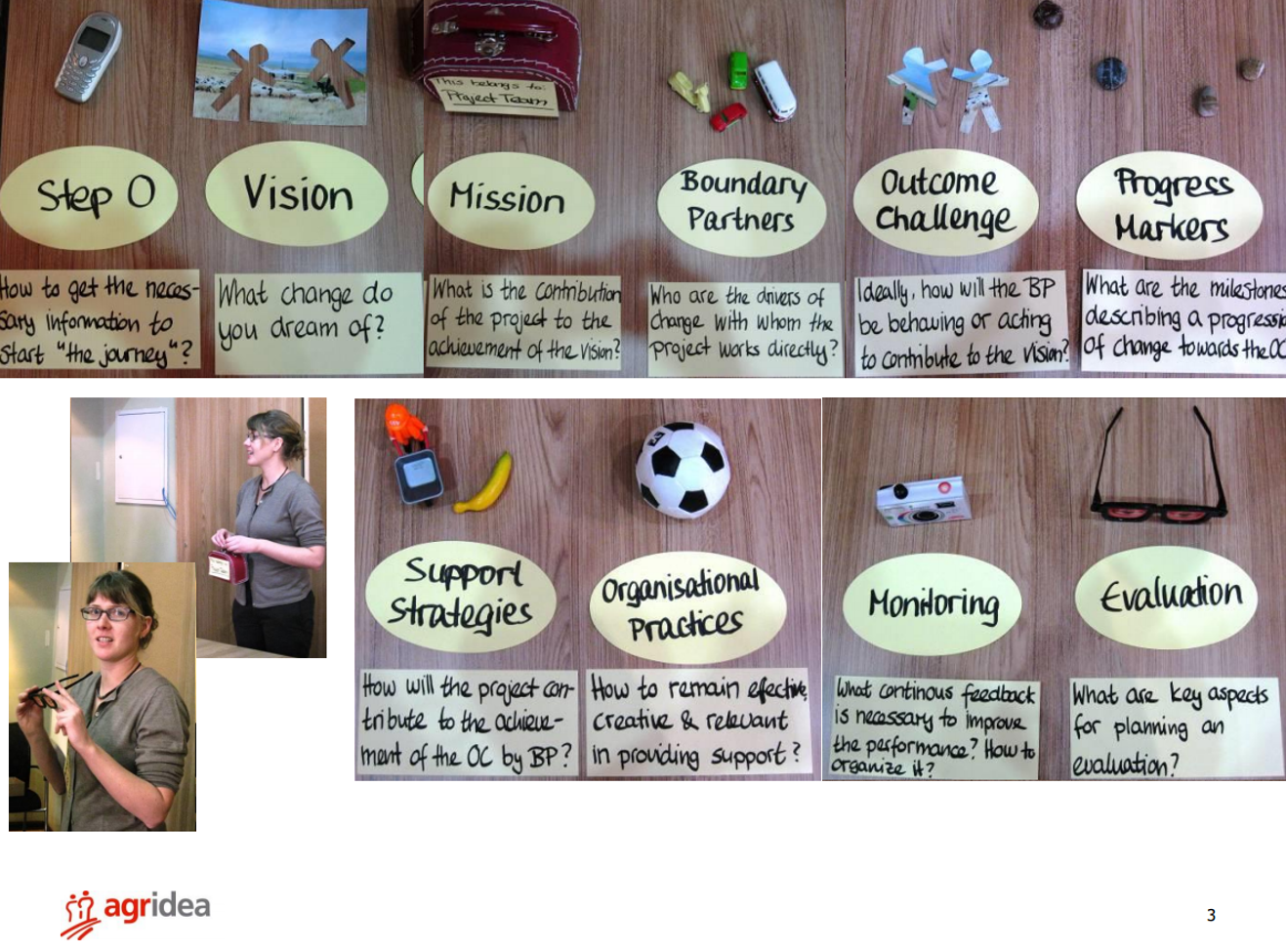Outcome Mapping Practitioner Guide
The Outcome Mapping Journey - An alternative way to introduce the steps and terminology of Outcome Mapping
This a story explaining the steps of Outcome Mapping. Every step is visualised by an object and embedded in the story of a journey.
Author: Corinne Sprecher
Published: Monday 20 October 2014
 After I had conducted for the first time an OM training, I was looking for a way to explain the method in a different way. Not using the powerpoint-slides commonly used, but something different, something like a story, something a bit playful. And I started to think about objects that could stand as symbols for each step... That was the beginning of the Outcome Mapping Journey!
After I had conducted for the first time an OM training, I was looking for a way to explain the method in a different way. Not using the powerpoint-slides commonly used, but something different, something like a story, something a bit playful. And I started to think about objects that could stand as symbols for each step... That was the beginning of the Outcome Mapping Journey!
In the meantime I have told the story about the Outcome Mapping Journey many times and it has facilitated the understanding of the OM steps in trainings. In the beginning I used the story as a repetition of the OM steps after the usual introduction. Now I often use it quite early in the training, after I have introduced some basic principles of OM. The visualisation of each step makes it easy to grasp and it has showed to be a very good entry point into the methodology. I leave the visualisation in the room for the whole duration of the training so that the participants can go back to look at it also later.
I visualise each step with an object and on visualised key question.
Once upon a time I have met in a place a motivated group of people who wanted to leave for a journey... They showed me a postcard of the place they wanted to go and told me about their imaginations what it would be like there....
Vision: Postcard - What change do you dream of?
Mission: Suitcase (labelled with: belongs to the project team) - What is the contribution of the project team to contribute to the achievement of the vision?
Before you leave on a journey, you make your suitcase and ask yourself what to take along. This depends on what you actually own, but also on what kind of trip you plan (hiking trip, city trip, holiday on the beach etc.), what you like to do etc.
Boundary partners: vehicles (cars, bikes, bus) - Who are the driver of change with whom the project works directly?
Who are actually the people who leave for the journey? Who are the ones that have the willingness and the means to travel? Who can also take some others along (bus)?
Outcome Challenges: I take the postcard (vision) and cut out two little people. Ideally, how will the boundary partner be behaving or acting to contribute to contribute to the vision.
Me cutting the vision usually makes a nice break in the story for people to reflect. They are usually a bit shocked that I cut vision! But really, what are nice visions for if we do not dare to break them down into contributions of everyone to the vision.
Progress Markers: Stones - What are the milestones describing a progression of change towards the outcome challenge?
Support Strategies: I open the suitcase and I take out a banana and a little workmen. How will the project contribute to the achievement of the Outcome Challenge by the Boundary Partner?
The project can support the "travellers" in different ways: providing a snack along the way to make them strong, building roads for the journey ...
Organisational Practices: Football - How to remain effective, creative and relevant in providing support?
This needs regular training and team-building to keep up with the developing boundary partners.
Monitoring: Camera - What continuous feedback is necessary to improve the performance? How to organise it?
Here I take the camera and I take a photo of the progress markers, the support strategies and the organisational practices. We have to ask ourselves: What 'photos' are necessary along the way? Who will take them? How often? etc.
Evaluation: Glasses - What are key aspects for planning an evaluation?
I put on some funny glasses with "eyes built in". This makes listeners laugh! One day some outsider will look at the project with his or her eyes. It is wise to decide already early in the planning, what kind of eyes should be looking at the project, where you want them to look at more precisely etc.
And then I say: Oh, I have forgotten something... before actually starting a journey, we usually need some preparation...
Step 0: mobile phone - How to get the necessary information to start "the journey".
Before you usually leave for a journey, you call some people, who've been there before, or who have made a similar experience, etc.
In addition, we usually work with a colour code for each step. This means I write the steps and the key questions on a specific card, depending on where the focus lays in this step:
project team - blue
boundary partners - green
'beneficiaries' - white
Before the journey we have introduced the model of sphere of control - sphere of influence - sphere of interest. The colour code adds to the understanding.
See also the attached photos.
This nugget was applied in: In various OM trainings in Benin, Mongolia, Bhutan, Georgia, Switzerland (in English, French and German)
Related Practitioner Guide sections:
Associated resources:




